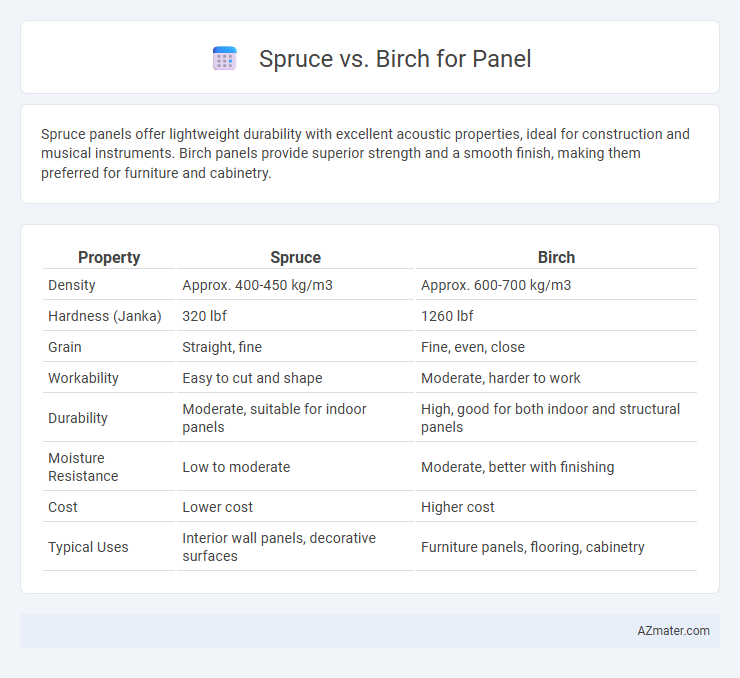Spruce panels offer lightweight durability with excellent acoustic properties, ideal for construction and musical instruments. Birch panels provide superior strength and a smooth finish, making them preferred for furniture and cabinetry.
Table of Comparison
| Property | Spruce | Birch |
|---|---|---|
| Density | Approx. 400-450 kg/m3 | Approx. 600-700 kg/m3 |
| Hardness (Janka) | 320 lbf | 1260 lbf |
| Grain | Straight, fine | Fine, even, close |
| Workability | Easy to cut and shape | Moderate, harder to work |
| Durability | Moderate, suitable for indoor panels | High, good for both indoor and structural panels |
| Moisture Resistance | Low to moderate | Moderate, better with finishing |
| Cost | Lower cost | Higher cost |
| Typical Uses | Interior wall panels, decorative surfaces | Furniture panels, flooring, cabinetry |
Introduction to Spruce and Birch Wood
Spruce and birch are two popular softwoods used for paneling, each offering distinct characteristics suited to various applications. Spruce wood is lightweight, has a fine grain, and provides excellent strength-to-weight ratio, making it ideal for construction and interior paneling where stability is essential. Birch wood features a smooth texture, high durability, and a warm, light color that enhances aesthetic appeal, commonly used in decorative panels and furniture veneers.
Botanical Differences: Spruce vs Birch
Spruce and birch panels differ significantly in their botanical characteristics, with spruce belonging to the Pinaceae family and birch classified under the Betulaceae family. Spruce trees are coniferous evergreens featuring needle-like leaves and woody cones, while birch trees are deciduous hardwoods characterized by broad leaves and distinctive papery bark. These botanical differences influence the wood's grain, density, and durability, making spruce lighter and softer compared to the harder, denser birch panels used for varied interior applications.
Appearance and Grain Comparison
Spruce panels offer a light, creamy color with a fine, uniform grain that provides a clean and smooth aesthetic, making them ideal for contemporary interior designs. Birch panels feature a warmer, slightly reddish tone with a more pronounced, tight grain pattern that adds character and natural texture, suitable for rustic or traditional decor. The choice between spruce and birch for paneling hinges on the desired visual effect: spruce delivers a subtle, minimalist look while birch presents a richer, more dynamic appearance.
Strength and Durability of Spruce and Birch Panels
Spruce panels are known for their excellent strength-to-weight ratio, making them ideal for structural applications where lightweight durability is crucial. Birch panels offer superior hardness and impact resistance, providing enhanced durability especially in high-traffic or load-bearing scenarios. Both woods have strong mechanical properties, but spruce excels in flexibility and resilience, while birch delivers greater wear resistance and long-term stability.
Workability and Ease of Finishing
Spruce panels offer excellent workability due to their lightweight nature and uniform grain, enabling smooth cutting, sanding, and shaping with minimal effort. Birch panels provide a harder, denser surface that requires more effort in machining but yields a superior, smooth finish ideal for staining and painting. Choosing between spruce and birch hinges on balancing ease of handling with the desired quality of the finished surface in woodworking projects.
Acoustic Properties for Paneling
Spruce panels offer superior sound resonance and are widely favored in acoustic applications due to their lightweight and consistent grain structure, enhancing sound clarity and warmth. Birch panels provide higher density and durability, resulting in better sound insulation and reduced reverberation, making them ideal for environments requiring noise control. Choosing between spruce and birch for paneling depends on prioritizing sound projection versus sound absorption in acoustic design.
Cost Comparison: Spruce vs Birch Panels
Spruce panels generally cost less than birch panels due to the faster growth rate and wider availability of spruce trees. Birch, known for its durability and finer grain, commands a higher price, making it a premium option for paneling. Budget-conscious projects often opt for spruce panels, balancing cost-effectiveness with adequate performance.
Environmental Impact and Sustainability
Spruce panels offer a lower environmental impact due to faster growth rates and higher carbon sequestration compared to birch, making spruce a more sustainable choice for wood paneling. Birch, while denser and more durable, generally requires longer growth periods and more intensive harvesting practices, which can increase its ecological footprint. Sustainable forestry certifications such as FSC or PEFC are critical in ensuring both spruce and birch panels are sourced responsibly, minimizing deforestation and promoting ecosystem health.
Best Uses for Spruce Panels
Spruce panels are ideal for interior wall cladding, acoustic panels, and lightweight furniture due to their excellent strength-to-weight ratio and fine, uniform grain. Their natural resistance to decay and high stiffness makes them suitable for structural applications like roofing and flooring where durability is crucial. Spruce's ability to hold nails and screws firmly ensures reliable fastening in panel construction, making it a preferred choice over birch for projects requiring stability and resilience.
Best Uses for Birch Panels
Birch panels are highly valued for their strength, smooth grain, and durability, making them ideal for cabinetry, furniture, and interior paneling where a clean, refined appearance is desired. Unlike spruce, which is softer and more suited for structural uses or musical instruments, birch offers greater resistance to wear and impact, enhancing its longevity in high-traffic environments. The dense, fine texture of birch panels also takes paint and finishes well, providing versatility for aesthetic customization in residential and commercial applications.

Infographic: Spruce vs Birch for Panel
 azmater.com
azmater.com